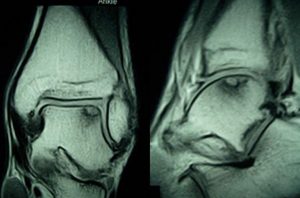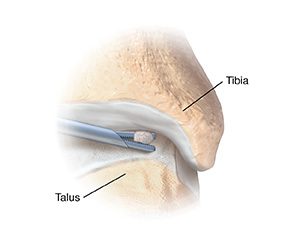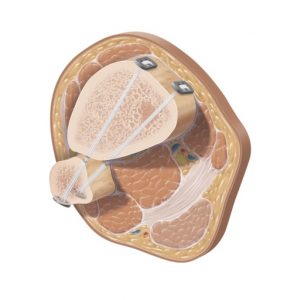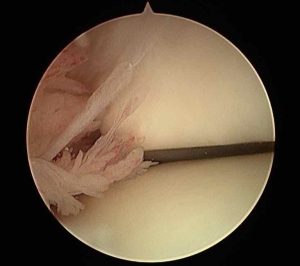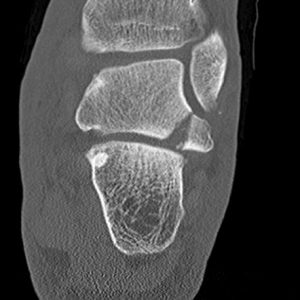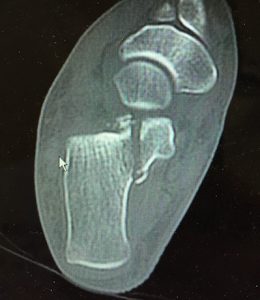Orthopaedics 360
Ankle sprains vary in severity. While the majority of ‘simple’ ankle sprains go onto a good recovery, there are a substantial subset of patients with more ‘complex’ injuries that have ongoing pain following ankle sprain. At the time of the injury, it is possible for damage to occur to the ankle joint itself, as well as the surrounding soft tissues and tendons.
Pain following ankle sprain is often associated with ongoing swelling and a loss of confidence in the stability of the ankle. Depending on the location of the pain, various pathologies need to be considered.
Pain at the front (Anterior) of the ankle joint
This is a common area to experience ongoing pain following ankle sprain. Pain in this region is likely due to either joint surface (chondral/articular surface) damage or associated ‘impingement’ from soft tissue scarring.
Talus OCD
The ‘Talus’ is a large bone of the ankle that articulates with the lower end of the tibia (shin bone) and fibula. Cartilage damage can occur in the anterolateral (front/outside) part of the talus, following a twisting injury. Impaction occurs between the talus and the lower end of the fibula, resulting in loss of cartilage in this area. A keyhole ankle arthroscopy is frequently required, and then the cartilage damage needs to be addressed.
Loose Bodies Inside the Ankle Joint
During a high energy ankle sprain, cartilage impaction can result in the formation of loose bodies that become entrapped within the ankle joint. These ‘bodies’ can increase in size once detached. Patient will typically have ongoing pain and the sensation of something ‘catching’ inside the ankle joint. The loose bodies may move around inside the joint causing intermittent ‘locking’ of ankle movement.
Soft Tissue or Bony Impingement
Anterior ankle impingement is characterised by pain at the front of the ankle joint during activities that result in ‘dorsiflexion’ of the ankle. Patients typically have difficulty with walking upstairs, landing from a jump, and pushing the brake in the car. Impingement occurs due to compression of bony or soft tissue structures during these activities.
Syndesmosis Injury (‘High’ Ankle Sprain)
The ankle syndesmosis is a ‘fibrous joint’ between the lower end of the tibia (shin bone) and fibula. Syndesmotic injuries are often referred to as a ‘High ankle sprain’ as the torn ligaments of the syndemosis, lie above the more commonly injured lateral ankle ligaments. The pain is often located just above the level of the ankle joint, and is made worse with external rotation of the foot.An early diagnosis of a syndesmosis injury is important, as the management differs from a ‘simple’ ankle sprain. Depending on the severity of the injury, surgery to stabilise this ‘joint’ may be required.
Persistent pain and swelling following a ‘sprain’ needs review
Pain on the outer (Lateral) side of the ankle joint
This is very common
This is the most common location for pain following ankle sprain. There are many causes that require a thorough assessment and management plan.
Ankle Synovitis
Ankle synovitis is inflammation of the soft tissue lining of the ankle joint. This can occur following an ankle sprain, with pain and swelling felt just in front of the lateral malleolus (end of the fibula). If this pain fails to settle, an ankle arthroscopy may be performed to remove the inflamed tissue.
Soft Tissue Scarring within the ankle joint
The typical ankle sprain results in tearing to the lateral ankle ligaments. Scarring of these ligaments can result in a condition termed ‘fibrosis’. This scarring can cause pain on the outer side of the ankle joint, and responds well to an arthroscopic ‘debridement‘ if it fails to settle.
Missed Bony Fracture
Ongoing lateral (outer) sided ankle pain, may be the result of a missed fracture. The most common locations for this include
- Anterior Process of Calcaneus
- Lateral process of Talus
- Base of 5th metatarsal
Peroneal Tendon Tears | Inflammation
The peroneal tendons run down the outside of the leg and behind the lower end of the fibula. They are vital in providing stability to the ankle joint. The peroneal tendons (especially the peroneus brevis) may be torn as a result of the ankle injury. Ongoing pain on the outside of the ankle (behind the lower fibula) and swelling will occur. An MRI scan confirms the diagnosis and surgical repair is often required.
Pain on the inner (medial) side of the ankle joint
Depending on the mechanism of injury, ongoing pain on the inside of the ankle joint may represent a missed bony injury (sustentaculum tali fracture), deltoid ligament rupture, or an injury to the talus articular cartilage on the inner (medial) side.
Sustentaculum Tali Fracture
The ‘Sustentaculum Tali’ is a prominence of bone that is part of the calcaneus (Heel bone). This diagnosis is easily missed and requires a high index of suspicion. A CT scan helps confirm the diagnosis and management may require screw fixation for optimal outcome.
Deltoid Ligament Tear
The deltoid ligament is a broad fan shaped ligament that lies on the medial (inner) side of the ankle. Injury to this ligament occurs with excessive ‘external rotation’ of the foot. It can be seen in isolation, but often is in combination with a fracture to the fibula.
Talus OCD – Cartilage Damage.
While cartilage damage more commonly affects the lateral (outer) side of the talus, following an injury, it is possible for the medial (inner) talus cartilage to be damaged also.
Pain in the back (posterior) area of the ankle joint
This is a less common region to experience ongoing pain. This typically represents ‘posterior ankle impingement’ that can occur due to the abutment of soft tissue or excessive bone (Os Trigonum).
Should you have recovered by now?
If you have ongoing pain and swelling and would like an assessment, please book into see our ankle surgeon – Dr. Smith
Ankle sprains and arthritis
People don’t generally tend to associate ankle sprains with ankle arthritis due to its seemingly innocuous presentation in comparison to ankle fractures or dislocations, however recurrent ankle sprains can result in serious trauma to the ankle. Post traumatic...
A seemingly simple ankle sprain can lead to ankle arthritis
Ankle arthritis is less common that Hip and Knee arthritis. In fact, while Hip and Knee arthritis is commonly attributed to genetics and ‘wear and tear’ with increasing age, the ethology of ankle arthritis is often quite different. The most common cause for someone...
Ankle Impingement
Ankle impingement is a common cause of ankle pain. We discuss what causes ankle impingement here.
Disclaimer: Please note that this is general advice only - for more information, please consult your regular doctor, or obtain a referral to see a specialist orthopaedic surgeon.
Orthopaedics 360
Orthopaedics 360
P: (08) 7099 0188
F: (08) 7099 0171
Southern Specialist Centre
Orthopaedics 360
P: (08) 7099 0188
F: (08) 7099 0171
Health @ Hindmarsh
Orthopaedics 360
P: (08) 7099 0188
F: (08) 7099 0171

